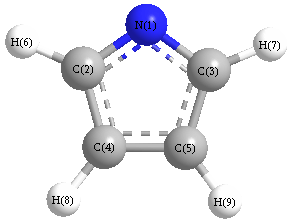Vibrational Frequencies calculated at CCD/6-31G*
| Mode Number |
Symmetry |
Frequency
(cm-1) |
Scaled Frequency
(cm-1) |
IR Intensities
(km mol-1) |
Raman Act
(Å4/u) |
Dep P |
Dep U |
|---|
| 1 |
A1 |
3296 |
3119 |
1.17 |
|
|
|
| 2 |
A1 |
3257 |
3082 |
2.35 |
|
|
|
| 3 |
A1 |
1657 |
1569 |
2.86 |
|
|
|
| 4 |
A1 |
1512 |
1431 |
27.60 |
|
|
|
| 5 |
A1 |
1263 |
1196 |
4.02 |
|
|
|
| 6 |
A1 |
1138 |
1078 |
40.10 |
|
|
|
| 7 |
A1 |
1087 |
1029 |
0.02 |
|
|
|
| 8 |
A1 |
905 |
857 |
11.51 |
|
|
|
| 9 |
A2 |
861 |
815 |
0.00 |
|
|
|
| 10 |
A2 |
857 |
811 |
0.00 |
|
|
|
| 11 |
A2 |
506 |
479 |
0.00 |
|
|
|
| 12 |
B1 |
853 |
807 |
0.00 |
|
|
|
| 13 |
B1 |
717 |
678 |
63.68 |
|
|
|
| 14 |
B1 |
571 |
540 |
24.57 |
|
|
|
| 15 |
B2 |
11378 |
10769 |
0.00 |
|
|
|
| 16 |
B2 |
3271 |
3096 |
110.98 |
|
|
|
| 17 |
B2 |
3249 |
3076 |
147.65 |
|
|
|
| 18 |
B2 |
1344 |
1273 |
0.85 |
|
|
|
| 19 |
B2 |
1321 |
1250 |
244.88 |
|
|
|
| 20 |
B2 |
1046 |
990 |
8.85 |
|
|
|
| 21 |
B2 |
894 |
847 |
61.34 |
|
|
|
Unscaled Zero Point Vibrational Energy (zpe) 20491.4 cm
-1
Scaled (by 0.9465) Zero Point Vibrational Energy (zpe) 19395.1 cm
-1
See section
III.C.1 List or set vibrational scaling factors
to change the scale factors used here.
See section
III.C.2
Calculate a vibrational scaling factor for a given set of molecules
to determine the least squares best scaling factor.
